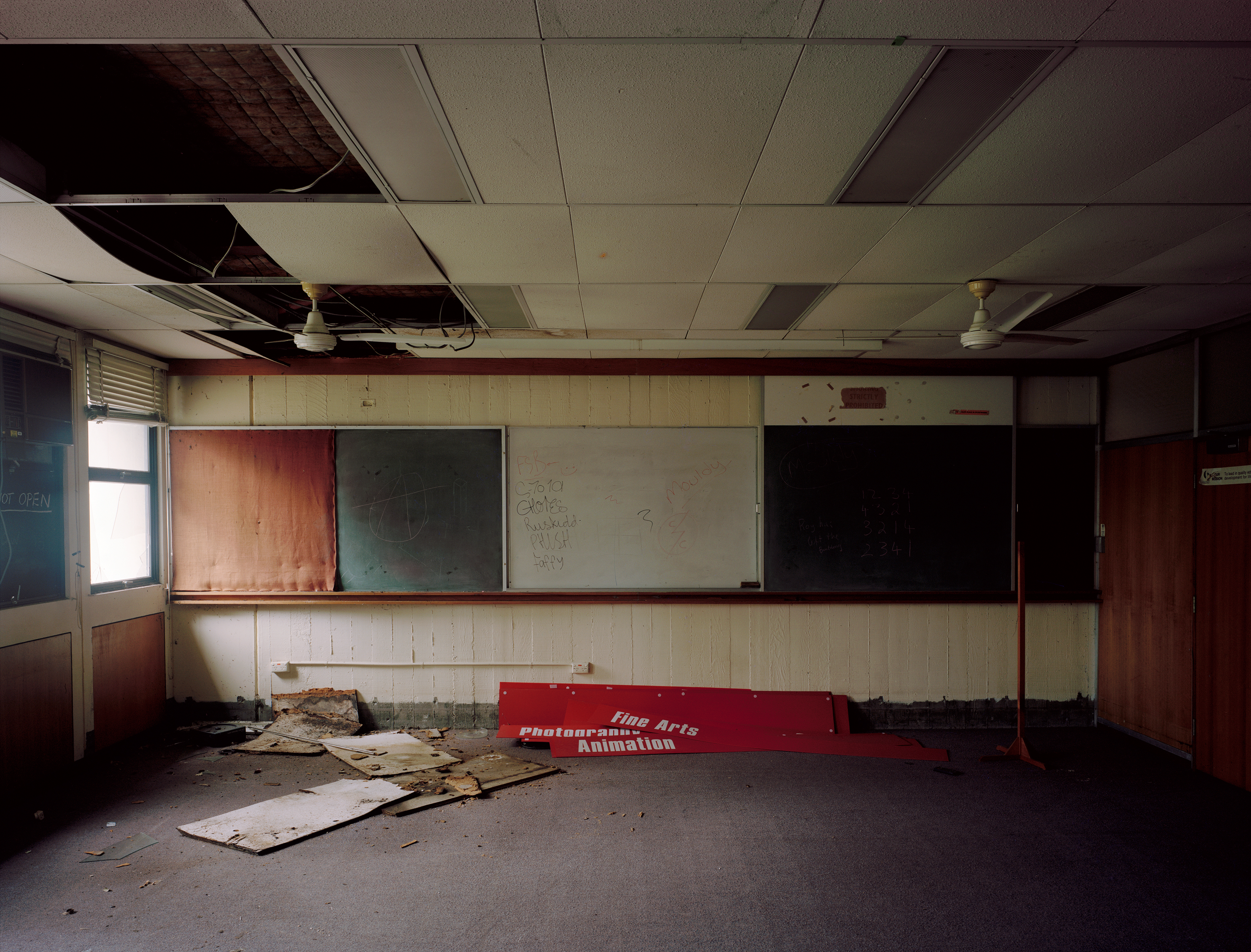Alma mater
Simon Cuthbert
POP Gallery
2023
It’s late afternoon on a Sunday in August and I’m in central Nipaluna /
Hobart with Simon Cuthbert. It’s very cold, gently raining, the light is diffuse
and shadowless. We’re on the corner of Cambpell and Bathurst street,
sizing up the facade of the old Royal Exchange Hotel. Cuthbert has been
closely monitoring the building over several months - sensitive to signs of
imminent development. He’s recruited my assistance in photographing the
hotel before it undergoes restoration; dignifying the shabby patina it’s
earned over the past 100 years. Using a large format field camera –
acquired from the old Forensic Imaging Unit of the Hobart Police – Cuthbert
snaps two quick frames of the hotel. His technique is affectless and austere:
muted lighting, formal framing, maximum focus, average exposure. These
decisions are habitual and made ‘in camera’. His negatives and prints
remain untouched in post-processing.
This “objective” approach to photography has been Cuthbert’s
methodology for over thirty years. Honed by the rigours of museum
photography - his ‘day job’ for just as long – Cuthbert is acutely attuned to
the indexical force of the photographic image. In the world of the museum,
the camera functions as a neutral mediator between subject and viewer,
and the photographer’s influence is erased through strict adherence to technical uniformity. This creates a clean slate for historical interpretation (all
subjects go through a kind of egalitarian visual flattening), and encourages
an unbiased environment for collective memory to unfold. That said, the
institution ultimately decides what is deemed worthy of the archive. Until,
like Cuthbert, the photographer peels themselves from the constraints of
the museum and starts to ‘choose’ their own subject matter; create their
own archive; chart their own map of memory. In Cuthbert’s case, he has
spent decades shaping a self-directed visual catalogue of our built
environment; eschewing heroic narratives in favour of the forgotten and the
neglected. He has done so with the precision of a scientist, the attitude of a
journalist, and the heart of a poet.
Cuthbert’s architectural typologies are couched in well established
photographic traditions from the late-20th Century. His work riffs off
sensibilities developed by the Düsseldorf School of Photography; an art
movement birthed through the teachings of Bernd and Hilla Becher in the
mid 1970’s in Germany. Averse to the dominance of expressive and
experimental photographic techniques at the time, the Becher’s encouraged
an attitude of detached observation, technical precision, and extreme image
detail. Their philosophy was akin to minimalism and ‘the readymades’ of
Marcel Duchamp, and their preferred subject matter was the man-made
world, the industrial, the engineered.
They went on to educate and influence
several generations of photographers, many now canonised giants in the
field, including Andreas Gursky, Candida Höfer, Thomas Ruff, Thomas
Struth, Edward Burtynsky, to name a handful. The school sought to elevate
the status of photography to the heights of contemporary art. They wanted their photographs to compete with the scale, prestige and immutability of
painting. They broadened our visual sensibilities to include the cold,
non-human logic of the mechanical gaze, and the artificial environment it
sprung from.
Cuthbert was studying at the Queensland College of Art (QCA) Seven Hills
campus, here in Meanjin / Brisbane, around the same time that The
Düsseldorf School’s star was rising internationally. Many of his generation
were taught in this groundbreaking style, and have held steadfast to it - for
good reason. Its capacity to exude authority is nearly unmatched. Its
sovereign, dispassionate gaze rivals the concrete veracity of social
documentary photography. Cuthbert leverages this powerful technique to
train our attention toward the marginal places of our lives and awareness.
The arresting detail and realism of his images court lengthy viewing often
not afforded to such places in real life. We linger empathetically in front of
his weary structures, witnessing their transmutation from architectural
detritus into moving portraits. They speak of loss and the relentless melt of
time. They are made in the spirit of 16th Century Momento Mori paintings -
helping us face the inevitability of change and endings.
Cuthbert has lived to see his college campus transform into a ruin, yet
although its material form has decayed, the energy and ideas seeded there
continue to flower into the present day. Seven Hills was just one of many
seasons at the QCA. The college finds its origins lying as far back as 1849,
on Queen Street - it’s the oldest arts institution in Australia. For better or for
worse, over time, we begin to trust that each iteration of the organism will mutate and adapt to meet the environmental conditions of the day. The
Seven Hills closure pathed the way for my generation to enjoy world class
facilities and art pedagogy. Many of the most efficacious educators
teaching my cohort were trained at Seven Hills. Cuthbert’s work is a visual
epitaph through which we may contemplate the significance and
impermanence of place in our lives. This exhibition also gives pause to
those of us who sense the shifting sands arriving again. How much longer
will the current South Bank campus hold, and what might its next material
evolution give way to?
Simon Cuthbert
Alma mater #5
2011/2012
